St Helens and District Tramways / New St Helens and District Tramways
History
The St Helens and District Tramways Company commenced operations on its newly constructed, standard-gauge tramway on the 5th November 1881; services were horse-drawn, a form of traction that was not best suited to the hilly country in and around St Helens.
Unfortunately, the company was burdened from the outset by under-capitalisation, and a local authority inclined to all manner of demands, many of them either unjustified or unreasonable, which made the system expensive to build and maintain. After a reasonable start, matters gradually went downhill, with the company unable to service its debt or carry out adequate maintenance, all of which was compounded by very poor management and a local authority which seemed intent on making the company's life as difficult as it possibly could. This toxic cocktail inevitably ended in receivership (in July 1888), from where the company was acquired by John Waugh (in 1889), a civil engineer from Bradford, who then commenced the job of rebuilding it as a steam tramway, before selling out to a new company — the St Helens and District Tramways Company — of which he was the chairman.
The old company had in fact obtained powers to operate a steam tramway in the town as early as 1883, but had been hamstrung by the council, which had prohibited the use of steam traction in certain central streets, a move no doubt designed to make its introduction operationally challenging and therefore uneconomical. It was clearly important to get the restrictions removed if the new company were to be successful, and in this, local opinion was to play a hand, effectively forcing the council to remove their objections, even though they were still enshrined in the original St Helens and District Tramways Act of 1883.
The StH&DTCo formally took over on the 1st February 1890, with the first steam service running barely a month later on the 3rd April, and the last horse service being withdrawn on the 12th May 1890. The steam tramway was 9.5 miles long, comprising lines from the centre of St Helens: westwards through Prescot to Brook Bridge (the municipal boundary); northwestwards to Denton's Green; northeastwards to Holly Bank Lane in Haydock; and southwards to Peasley Cross. The system was not connected to any of the neighbouring tramways during the steam era.
The company finally paid a dividend out of revenue in early 1895, going on to operate the system successfully — from both a service and a financial perspective — for the rest of its existence.
St Helens Corporation had always been minded to own and thus control the tramway within the borough, and in 1893 it sought and obtained powers to purchase the StH&DTCo's tracks, including those outside the borough boundary. Three years later, on the 1st of April 1897, the corporation purchased the track, thereby taking on responsibility for its maintenance, the StH&DTCo continuing to operate the system as the lessee. This decision was no doubt driven by a desire to convert the tramway to overhead electric traction, and in October 1897, the corporation formally decided to proceed.
The company were eager to operate the new system, but recognised that a significant injection of capital would be needed. Before it could proceed, however, control of the company passed into the hands of a number of individuals who were to play a significant role in the tramways of South Lancashire. A new company was soon formed to raise the necessary capital — the New St Helens and District Tramways Company — and after extended negotiations with the corporation, a 21-year lease was agreed, which was to run from the 1st October 1898. The first electric trams commenced running on the 20th July 1899, with the last steam service running on or around the 6th April 1900 (the precise date has not been recorded).
On the 25th June 1902, the NStH&DTCo also became the operator (i.e., the lessee) of the Liverpool and Prescot Light Railway, which connected with the St Helens system at Brook Bridge, running 3.11 miles southwestwards to the Liverpool Corporation Tramways terminus at Knotty Ash. The L&PLR was owned by the Lancashire Light Railways Company, a concern that shared several directors with the NStH&DTCo. In October 1906, a controlling interest in the NStH&DTCo was acquired by Lancashire United Tramways, which by this time also owned the South Lancashire Tramways Company and the LLRCo.
The relationship between the company and St Helens Corporation remained a tense one, with the latter seemingly intent on finding whatever it possibly could to raise a complaint, however trivial. It was, therefore, probably no surprise to the company when, in 1915, the corporation refused to entertain an extension of the lease, this having been requested by the company. The corporation no doubt cast envious glances at other municipal systems where the tramways had proven to be extremely profitable, the excess subsidising the rates as opposed to disappearing into the pockets of company shareholders. The corporation duly took full control of the tramway on the 1st October 1919 following expiry of the lease, buying the operating infrastructure (e.g., the tramcars) from the company. The latter probably got the best of the deal as the system, like many others, had emerged from the Great War in a very run-down state, requiring significant investment at a time of high costs and impending bus competition.
During the electric era, the NStH&DTCo operated 20.51 miles of tramway, 18.74 miles owned by St Helens Corporation and 1.77 miles leased from the SLTCo. The system comprised lines from the centre of St Helens: westwards to Brook Bridge via both Prescot and Rainhill; northwestwards to Denton's Green; northwards to Windle; northeastwards to the Rams Head in Haydock; eastwards to Parr; and southeastwards to St Helens Junction. The system was connected to the L&PLR at Brook Bridge, and to the SLTCo in Haydock. Whilst LCT and SLTCo tramcars occasionally appeared in St Helens on special workings, there was no regular through-running in company days. The SLTCo did, however, lease operation of its line between Haydock and Ashton-in-Makerfield to the NStH&DTCo, with the latter operating through from St Helens to Ashton-in-Makerfield.
Uniforms
Photographs of St Helens and District Tramways Company horse trams are rare, but the single example shown below would seem to indicate that like most horse tram operators, the StH&DTCo was happy for its staff to wear informal attire, namely: heavy jackets and trousers, and the fashionable headgear of the day, the ubiquitous bowler hat. No insignia of any kind — either badges or licences — appears to have been carried, though given the paucity of photographic evidence, a high degree of caution must be exercised.
Following the introduction of steam tram services by the St Helens and District Tramways Company in 1890, conductors continued to wear informal but smart attire, comprising: jacket, trousers, shirt and tie, and invariably a bowler hat, though the latter appears to have been displaced in later years by the flat cap. Drivers wore very similar attire to their railway counterparts, namely: heavy cotton trousers and jackets, predominantly light in colour. No badges of any kind appear to have been worn, though the last steam tram photograph below does show a conductor wearing what is almost certainly a round, municipal licence — these were possibly introduced following the corporation take-over of 1st April 1897, the company thereafter becoming the lessee.
The two early electric-era photographs below, taken during the tenure of the New St Helens and District Tramways Company, indicate that staff working the new electric services wore double-breasted jackets with four pairs of buttons, a single breast pocket, and lapels; the jackets do not appear to have borne insignia of any kind. Caps were in a kepi-style with a glossy peak, and probably bore a large oval cap badge, possibly of embroidered cloth, details of which remain unknown. During these years, motormen — and probably conductors too — were required to wear round municipal licence badges when operating the services.
At some point prior to the corporation take-over of 1919, a switch was made to single-breasted jackets, though possibly only for conductors. These jackets bore five buttons, two breast pockets (with button closures), and stand-up collars; the latter do not appear to have borne any insignia. Motormen on the other hand appear to have worn double-breasted, lancer-style tunics with five pairs of buttons (narrowing from top to bottom) and stand-up collars; once again, it is unclear whether the latter bore any badges , but probably not. The kepi-style caps were superseded by tensioned-crown peaked caps; whilst it is still unclear what cap badge was used for conductors, motormen's caps bore an off-the-shelf script-lettering grade badge, 'Driver'.
Tramcar crews were alos provided with double-breasted greatcoats with high, fold-over collars; surviving photographs are hardly convincing, but they do seem to indicate that these garments were devoid of insignia.
Given that there is no documentary or photographic evidence of inspectors during steam days, it may well be that the SH&DTCo never employed them. During the early years of electric operation, inspectors wore similar uniforms to tramcar staff, along with kepi-style caps. The latter bore a large oval cap badge, possibly of embroidered cloth.
Although many systems employed female tramcar staff during the Great War, to replace men lost to the armed services, I can find no evidence that the NStH&DTCo did so; however, given the rarity of published material — photographic or otherwise — there remains every possibility that they did.
Further reading
For a history of the companies, see: 'St Helens Tramways' by E K Stretch; St Helens Corporation Transport (1968).
Images
Horse tram drivers and conductors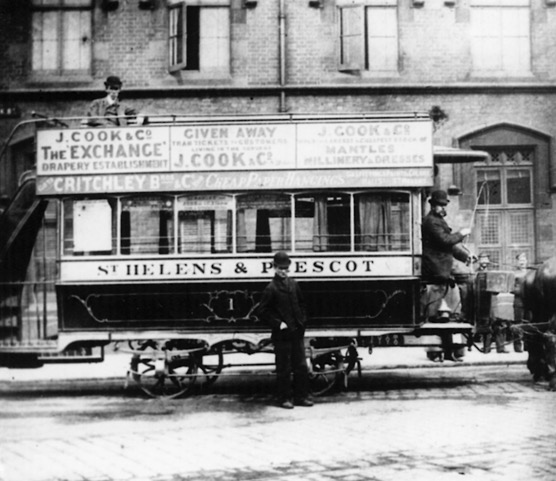
A driver and conductor pose for the camera with Horsecar No 1 in Ormskirk Street — photo undated, but almost certainly taken in the 1880s given that steam traction was introduced on this route on 3rd April 1890. Photo courtesy of the Tramways and Light Railway Society, with thanks to David Voice.
Steam tram drivers and conductors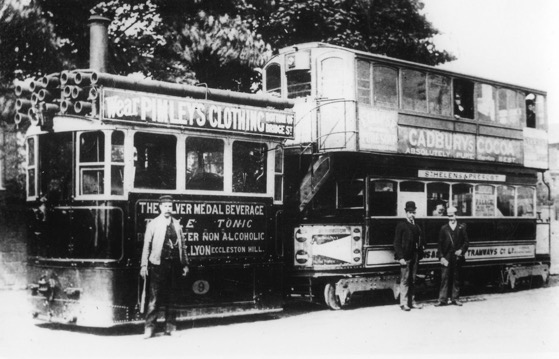
Steam Tram No 9 pictured on the Prescott route — photo purportedly taken in November 1891 when the engine was delivered. Author's Collection.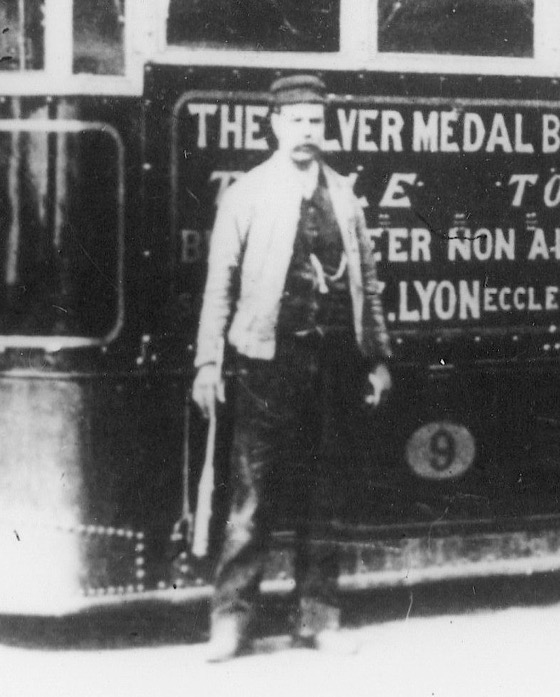
A blow-up of the above photo showing the driver, in cotton jacket and unmarked, soft-topped cap. He is carrying an oil can in his right hand.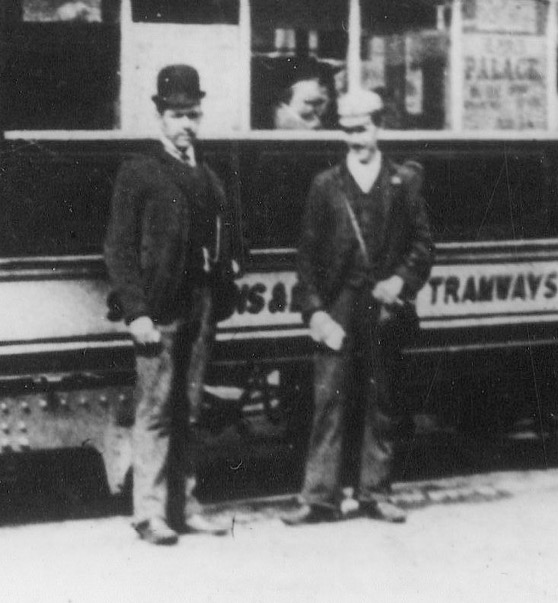
Another blow-up of the above photo, this time showing the conductor, who is wearing informal attire and a flat cap. The bowler-hatted figure is probably the manager or workshop foreman.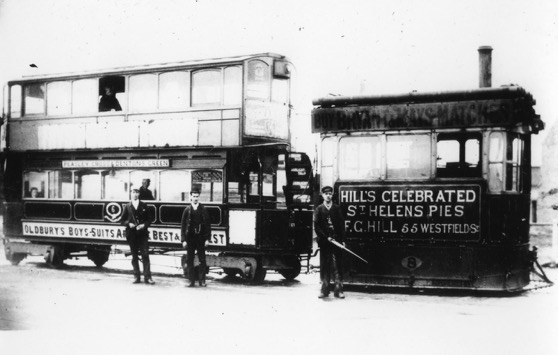
Steam Tram No 8 and Trailer No 6 on a Pleasley Cross to Dentons Green service — photo undated, but probably taken in the mid 1890s. The full company title on the rocker panel had by this time been replaced by advertisements, with the previously plain waist panel now carrying the company device in a garter. Author's Collection.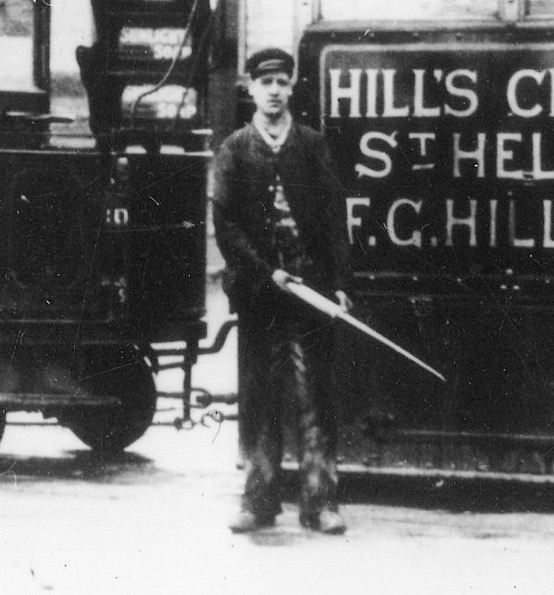
A blow-up of the above photo showing the driver, once again with oil can in hand.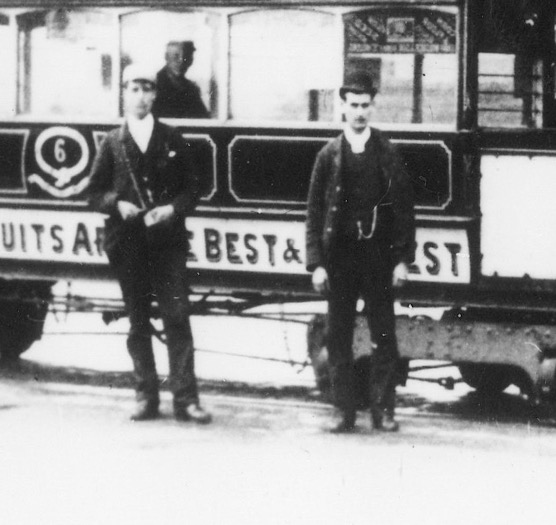
Another blow-up of the above photo, this time showing the conductor (on the left).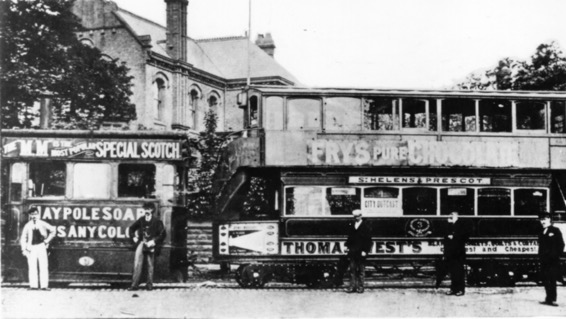
Another shot of Steam Tram No 9, with Trailer No 3, on a St Helens to Prescot service — photo undated, but probably taken in the mid 1890s. The conductor is wearing informal attire and a bowler hat. Photo courtesy of the Tramways and Light Railway Society, with thanks to David Voice.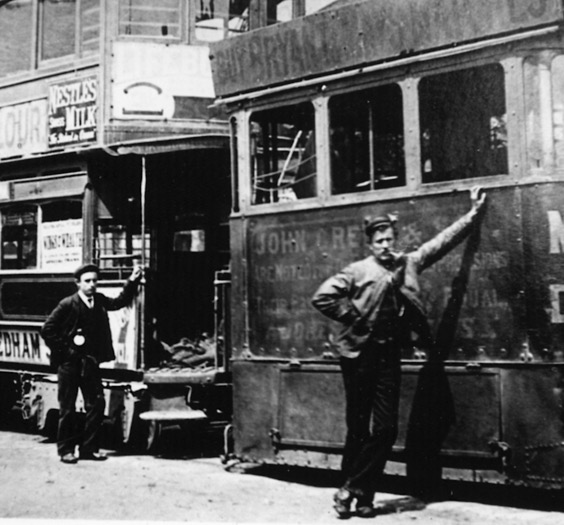
A driver and conductor pose for the camera with an unidentified steam tram and Trailer No 8, on a St Helens to Haydock service — photo undated, but given the rather tatty condition of the engine, probably after the corporation take-over (of the tracks) of 1897. This would also explain why the conductor is wearing a licence, as these were presumably introduced following the take-over. Photo courtesy of the Tramways and Light Railway Society, with thanks to David Voice.
Motormen and conductors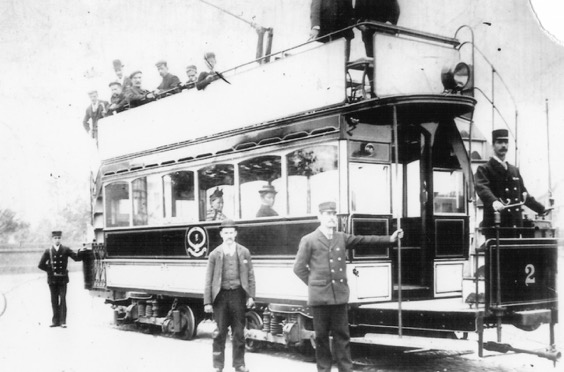
A conductor (rear) and a motorman (at the controls) pose for the cameraman with what is probably a brand-new Tramcar No 2, dating the photograph to very late in 1899 or early in 1900. The proprietorial-looking individual holding the stanchion is more than likely an inspector. Author's Collection.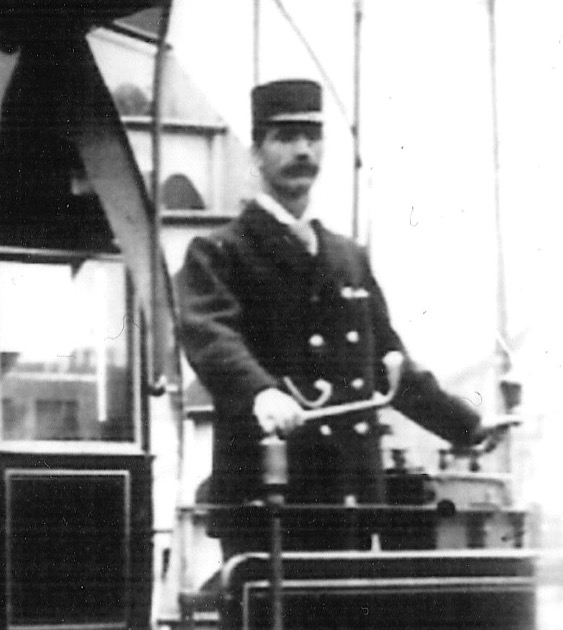
A blow-up of the above photo showing the motorman. He is wearing a double-breasted jacket and a kepi-style cap; although the image is rather poor, it seems to suggest that the cap bore a large oval cap badge.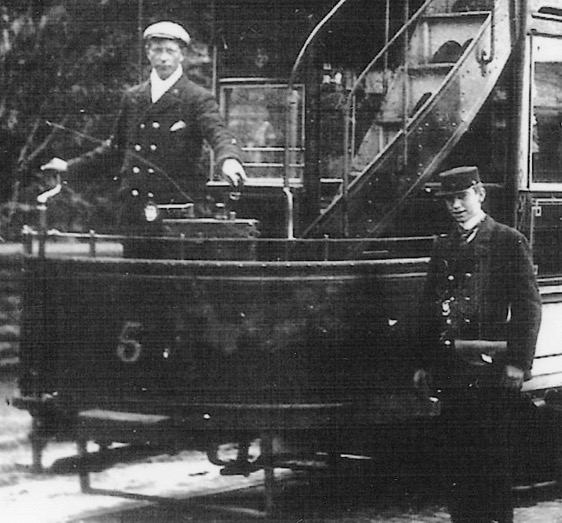
The crew of a brand-new Tramcar No 5 pose for the cameraman on a St Helens to Nutgrove service in 1900, the motorman in a flat cap, suggesting that the kepis were in short supply. Once again it is impossible to discern whether or not the conductor's kepi bears a cap badge, though if it did, the fact that no reflection is evident would tend to suggest that it was cloth. Author's Collection.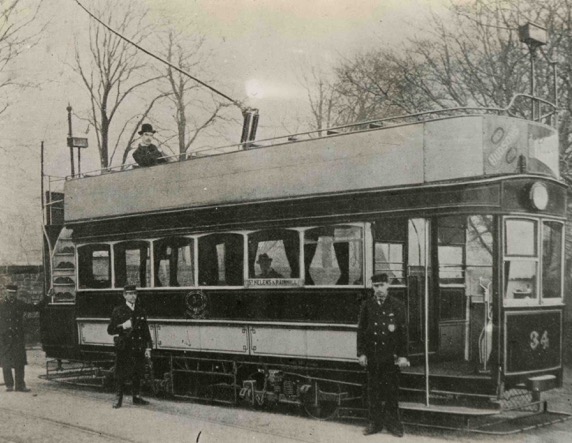
Three tramwaymen, a driver (?), conductor and driver, pose with Tramcar No 34 in New St Helens and District Tramways Company days — photo undated, but probably taken in the early Edwardian era. Photo courtesy of the Tramways and Light Railway Society, with thanks to David Voice.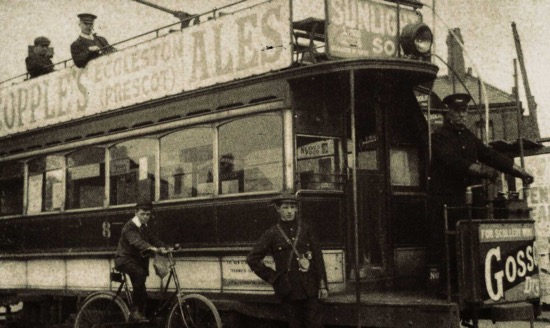
A poor-quality photograph, but one which shows a NStH&DTCo tramcar crew relatively late on in the company's tenure, around the time of the Great War. The photograph was possibly taken in High Street, Prescot.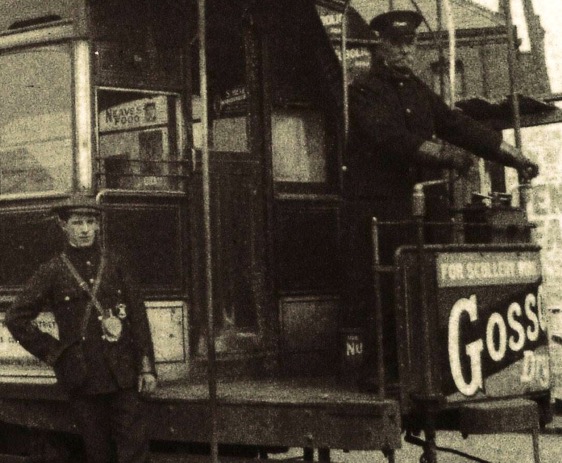
An enlargement of the above photograph showing the crew. The conductor is weating a single-breasted jacket with stand-up collars, seemingly devoid of insignia, the motorman a double-breasted greatcoat. The conductor is wearing a flat cap, the motorman a tensioned-crown peaked cap bearing what is, in all probability, a script-lettering 'Driver' cap badge. A round licence badge can just be made out above the conductor's ticket clipper.
Senior staff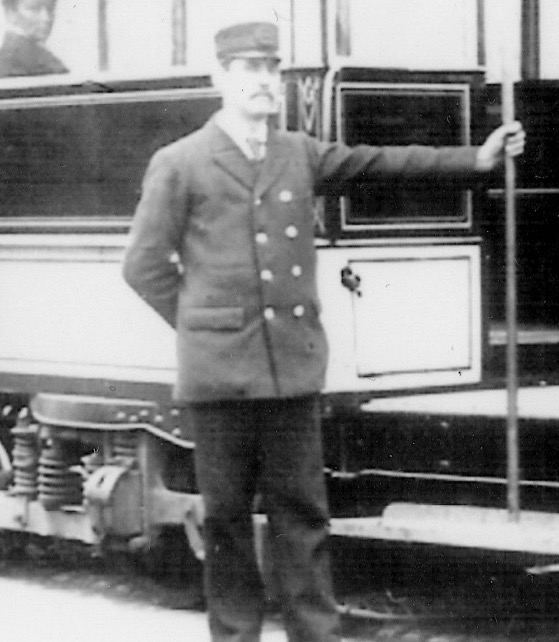
A blow-up of the photograph of Tramcar No 2 above, showing the inspector. His jacket appears to be plain — i.e., devoid of insignia — whereas his cap clearly carries a large oval cap badge, which appears to be of embroidered cloth.